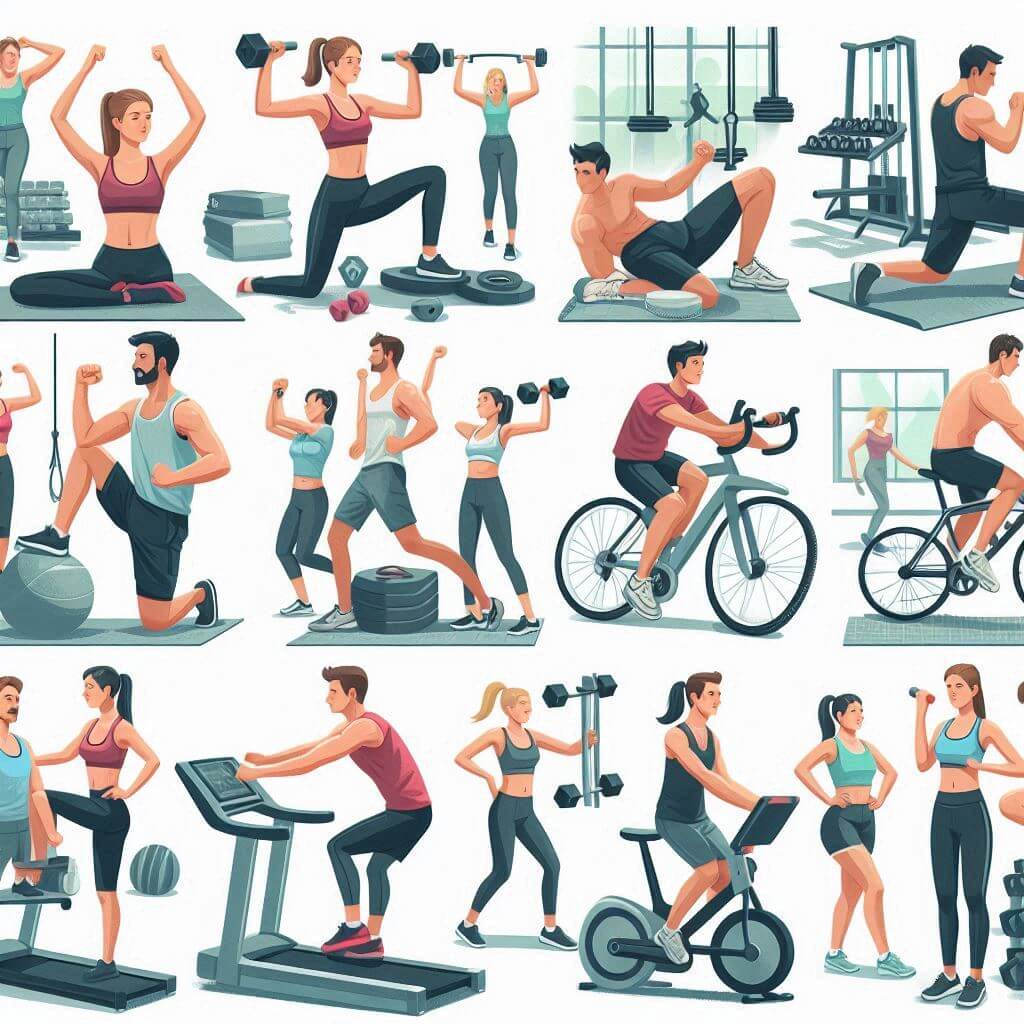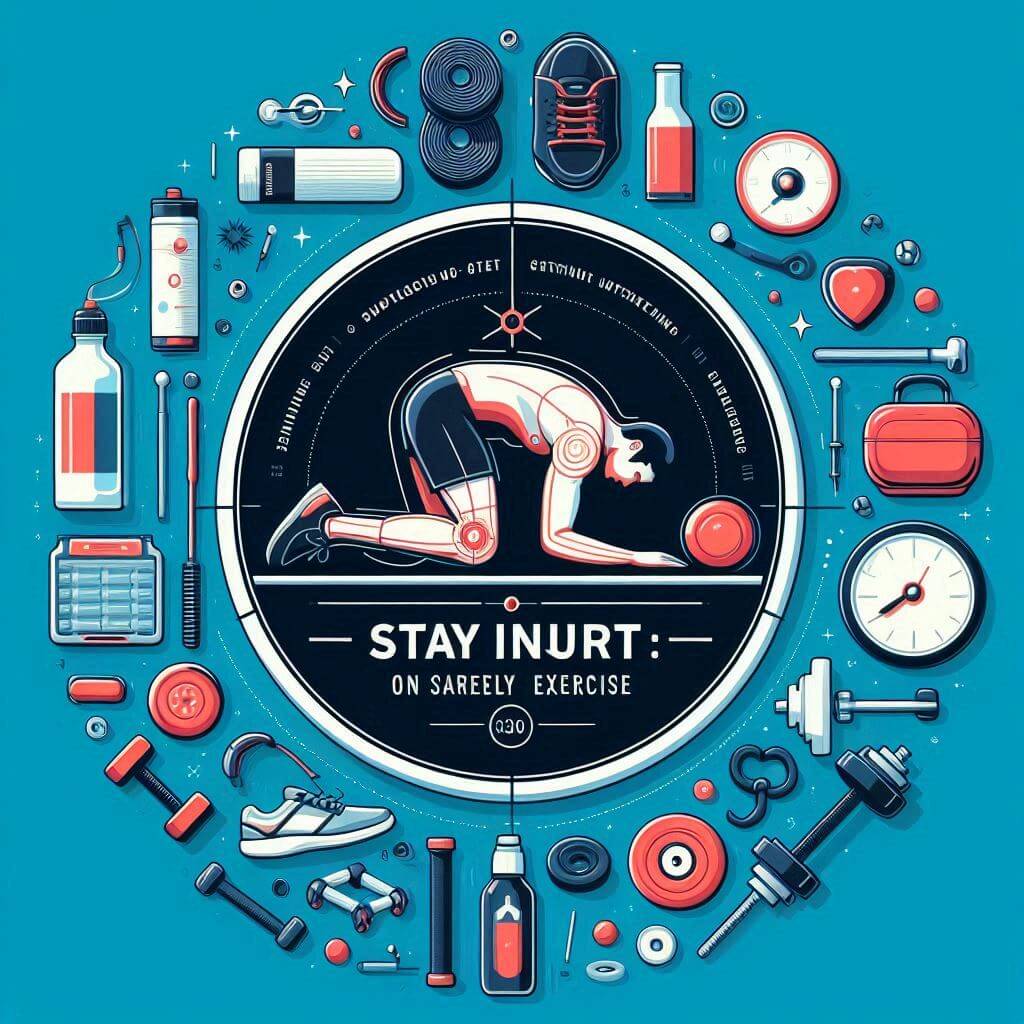THE nutritional reeducation is an important and necessary process to achieve a healthy and balanced lifestyle.
However, we often forget the importance of combining the food suitable with the practice of physical exercises.
In this guide, I will highlight the importance of exercise in injury-free eating, explain the different types of exercise, and provide tips on how to choose the best exercises to achieve your goals.
I will also cover muscle strengthening exercises, cardiovascular exercises, flexibility and mobility exercises, and high-intensity interval training (HIIT).
Plus, we’ll guide you through creating a personalized exercise plan for your healthy eating journey. Let’s get started!
The importance of exercise in nutritional reeducation
When it comes to eating disorders, most people focus only on diet and calorie counting.
However, exercise plays a fundamental role in losing weight, gaining muscle mass and maintaining a healthy lifestyle.
Additionally, regular exercise helps improve mood, increase energy, and reduce the risk of chronic diseases such as diabetes and heart disease.
By combining nutritional re-education with exercise, you create a healthy and sustainable lifestyle in the long term.
Exercise helps speed up the metabolism, burn extra calories and strengthen muscles.
Additionally, regular exercise increases feelings of well-being and helps maintain motivation.
Understanding the different types of exercises

They exist different types of exercises that you can incorporate into your dietary reeducation routine.
It is important to understand each of them to choose the best ones to achieve your goals.
Here are the main types of exercises you should consider:
Muscle strengthening exercises
Muscle strengthening exercises are essential for building muscle, increasing strength and improving body composition.
They involve the use of free weights, weight machines, or even your own body weight.
Examples of muscle-strengthening exercises include squats, weightlifting, push-ups, and planks.
These exercises should be performed two to three times a week, with a day of rest between sessions.
Cardiovascular exercises
Cardiovascular exercises are great for improving endurance, burning calories and strengthening the cardiovascular system.
They include activities such as running, swimming, cycling and dancing.
It is recommended to perform at least 150 minutes of moderate-intensity cardiovascular exercise per week, or 75 minutes of high-intensity cardiovascular exercise.
You can break these minutes down into 30- to 45-minute sessions, five days a week.
Flexibility and mobility exercises
Flexibility and mobility exercises are important to improve range of motion, prevent injuries, and promote good posture.
These include static stretches, joint mobility exercises, and myofascial release techniques.
It is recommended to perform these exercises at least twice a week, especially before and after muscle strengthening or cardiovascular exercise sessions.
High-intensity interval training (HIIT)
High-intensity interval training (HIIT) is an effective form of exercise that combines periods of high intensity with periods of active recovery.
This type of training helps burn extra calories, increases endurance and improves cardiovascular capacity.
Examples of HIIT exercises include sprints, burpees, jumping jacks, and explosive squats.
It is recommended to perform two to three HIIT training sessions per week, with at least one day of rest between sessions.
Choosing the Best Exercises for Your Injury-Free Goals

Now that you understand the different types of exercises, it’s important to choose the best ones to achieve your nutritional reeducation goals.
If you want to lose weight, cardiovascular exercise with muscle strengthening exercises is recommended to increase metabolism and burn extra calories.
If your goal is to gain muscle mass, focus on muscle-strengthening exercises that work all muscle groups.
If you are looking to improve your overall health and fitness, consider including a combination of cardiovascular, muscle-strengthening, flexibility and mobility exercises in your routine.
Muscle Strengthening Exercises to Build Muscle
Muscle strengthening exercises are essential for building muscle and increasing strength.
They include compound movements, which work several muscle groups at the same time.
Some examples of muscle-strengthening exercises include squats, weightlifting, push-ups, and planks.
It is important to perform these exercises correctly, paying attention to technique and proper posture.
Start with a weight or intensity that is challenging, but that you can do with good form.
As you gain strength, you can gradually increase the weight or intensity of your exercises.
Cardiovascular exercises to improve endurance and burn calories
Cardiovascular exercises are excellent for improving endurance, burning extra calories and improving cardiovascular health.
They include activities such as running, cycling, swimming and dancing.
To get the best results, it's important to choose activities that you enjoy and that fit into your routine.
Start with a moderate intensity and gradually increase the intensity and intensity of the exercises.
Remember to warm up before starting your exercise and cool down throughout your session.
Flexibility and mobility exercises to prevent injuries
Flexibility and mobility exercises are essential to prevent injuries, improve posture and increase range of motion.
These include static stretches, joint mobility exercises, and myofascial release techniques.
It is important to perform these exercises regularly, especially before and after muscle strengthening or cardiovascular exercise sessions.
Start with gentle movements and gradually increase the intensity and duration of the exercises.
Pay attention to your breathing and try to relax your muscles as you stretch.
High-intensity interval training (HIIT) for maximum calorie burn
High-intensity interval training (HIIT) is an effective form of exercise that combines periods of high intensity with periods of active recovery.
This type of training helps burn extra calories, increases endurance and improves cardiovascular capacity.
Examples of HIIT exercises include sprints, burpees, jumping jacks, and explosive squats.
For best results, it is important to perform these exercises at maximum intensity during work periods and make the most of active recovery periods.
Start with low-moderate intensity HIIT training and gradually increase the intensity and duration of your sessions.
Creating a Custom Exercise Plan

Now that you understand the different types of exercises and how to choose the best ones for your goals, it’s time to create a personalized exercise plan for your nutrition recovery journey.
- Set your goals: Determine what you want to achieve with your exercise, whether it’s losing weight, gaining muscle mass, or improving your overall health.
- Consider your schedule: Consider your available time and daily routine when creating your exercise plan. Choose times and days that are feasible and realistic for you.
- Vary your routine: Include a variety of exercises in your plan to avoid boredom and maximize results. Alternate between cardio, muscle-strengthening, flexibility and mobility exercises, and HIIT training.
- Gradually increase intensity: As you gain strength and endurance, gradually increase the intensity and duration of your workouts. This will help maintain the challenge and prevent plateauing in results.
- Consult a professional: If you are a beginner or have health concerns, it is always advisable to consult a fitness professional or doctor before starting a new exercise program.
Remember that every body is unique and what works for one may not give results for another.
Therefore, it is important to listen to your body, make adjustments as necessary, and find the right balance between exercise and nutritional re-education.
Tracking progress and adjusting your exercise routine
Tracking your progress is key to staying motivated and ensuring you’re on track to achieve your weight loss goals. Here are a few ways to track your progress: This will help you track your progress over time.
- Keep an exercise diary: Write down the exercises you do perform, the number of repetitions, sets, weight used and how you feel during and after training. Take photos: Take photos of your body from time to time to see the changes in your body composition. This can be a great motivation and a tangible way to see your progress.
- Measure your stats: Measure parts of your body, such as your waist, hips, chest, arms, and legs. This will help you see changes in your body, even if the scale doesn’t show a big difference.
- Get regular physical assessments: Consider getting regular physical assessments from a fitness professional to track your progress in terms of strength, endurance, and body composition.
Additionally, it’s important to adjust your exercise routine as needed to avoid plateauing and continue progressing.
Gradually increase the intensity, weight, or duration of your exercises to continue challenging your body. If necessary, consult a fitness professional for personalized guidance.
The role of rest and recovery in exercise and nutritional re-education
Finally, it’s important to remember that rest and recovery are just as important as the exercise itself.
Your body needs time to recover and repair muscles after exercise. Here are some tips to ensure you get plenty of rest and recovery:
- Respect rest days: Include at least one or two rest days in your workout week to allow your body to recover properly.
- Get enough sleep: Make sure you get good quality sleep and get enough sleep every night. Sleep helps with muscle recovery and regulating appetite hormones.
- Post-exercise nutrition care: Consume a meal or snack that contains a combination of proteins and carbohydrates within an hour after exercise. This will help replenish energy stores and promote muscle recovery.
- Do active recovery activities: Include active recovery activities, such as yoga, gentle stretching, or light walking, on rest days to promote blood circulation and relieve stress.
Here is a FAQ:
| Question | Response |
|---|---|
| What is nutritional reeducation? | Food re-education is a gradual process of changing eating habits, focused on healthy and balanced choices for adequate nutrition in the long term. |
| Why should I combine nutritional re-education with physical exercise? | The combination improves body composition, speeds up metabolism, increases muscle strength, and promotes overall health and well-being. |
| What is the best type of exercise for weight loss? | Cardiovascular exercises, such as running, cycling and swimming, are effective for burning calories. Combining them with strength training boosts your metabolism. |
| What is HIIT and what are its benefits? | HIIT (High-Intensity Interval Training) combines short bursts of high intensity with recovery. It burns more calories in less time and improves cardiovascular fitness. |
| How often should I do muscle strengthening exercises? | It is recommended to practice muscle strengthening exercises 2 to 3 times a week, with 48 hours of rest between sessions. |
| What are the benefits of flexibility and mobility exercises? | These exercises increase range of motion, prevent injuries, improve posture, and help relieve muscle tension. |
| How can I create a custom exercise plan? | Set clear goals, vary between cardio, strength and flexibility exercises, increase intensity gradually and adjust as needed to maintain progress. |
| Do I need to stretch before and after exercising? | Yes. Dynamic stretching before a workout prepares your muscles, while static stretching after a workout helps with recovery and flexibility. |
| How important is rest when exercising? | Rest is essential for muscle recovery and injury prevention. Include 1 to 2 rest days per week and get adequate sleep. |
| What is the ideal post-workout diet? | Ideally, you should consume a meal or snack with protein and carbohydrates within an hour after training to help with muscle recovery and energy replenishment. |
quick reading information query!









